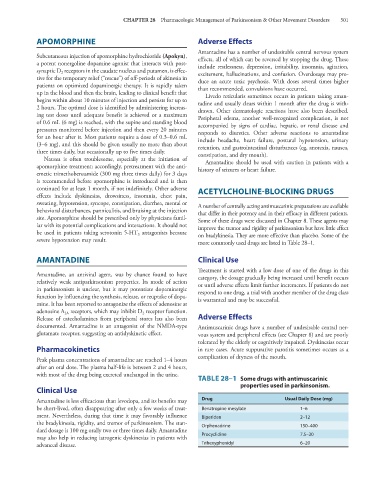Page 515 - Basic _ Clinical Pharmacology ( PDFDrive )
P. 515
CHAPTER 28 Pharmacologic Management of Parkinsonism & Other Movement Disorders 501
APOMORPHINE Adverse Effects
Amantadine has a number of undesirable central nervous system
Subcutaneous injection of apomorphine hydrochloride (Apokyn), effects, all of which can be reversed by stopping the drug. These
a potent nonergoline dopamine agonist that interacts with post- include restlessness, depression, irritability, insomnia, agitation,
synaptic D receptors in the caudate nucleus and putamen, is effec- excitement, hallucinations, and confusion. Overdosage may pro-
2
tive for the temporary relief (“rescue”) of off-periods of akinesia in duce an acute toxic psychosis. With doses several times higher
patients on optimized dopaminergic therapy. It is rapidly taken than recommended, convulsions have occurred.
up in the blood and then the brain, leading to clinical benefit that Livedo reticularis sometimes occurs in patients taking aman-
begins within about 10 minutes of injection and persists for up to tadine and usually clears within 1 month after the drug is with-
2 hours. The optimal dose is identified by administering increas- drawn. Other dermatologic reactions have also been described.
ing test doses until adequate benefit is achieved or a maximum Peripheral edema, another well-recognized complication, is not
of 0.6 mL (6 mg) is reached, with the supine and standing blood accompanied by signs of cardiac, hepatic, or renal disease and
pressures monitored before injection and then every 20 minutes responds to diuretics. Other adverse reactions to amantadine
for an hour after it. Most patients require a dose of 0.3–0.6 mL include headache, heart failure, postural hypotension, urinary
(3–6 mg), and this should be given usually no more than about retention, and gastrointestinal disturbances (eg, anorexia, nausea,
three times daily, but occasionally up to five times daily. constipation, and dry mouth).
Nausea is often troublesome, especially at the initiation of
Amantadine should be used with caution in patients with a
apomorphine treatment; accordingly, pretreatment with the anti- history of seizures or heart failure.
emetic trimethobenzamide (300 mg three times daily) for 3 days
is recommended before apomorphine is introduced and is then
continued for at least 1 month, if not indefinitely. Other adverse ACETYLCHOLINE-BLOCKING DRUGS
effects include dyskinesias, drowsiness, insomnia, chest pain,
sweating, hypotension, syncope, constipation, diarrhea, mental or A number of centrally acting antimuscarinic preparations are available
behavioral disturbances, panniculitis, and bruising at the injection that differ in their potency and in their efficacy in different patients.
site. Apomorphine should be prescribed only by physicians famil- Some of these drugs were discussed in Chapter 8. These agents may
iar with its potential complications and interactions. It should not improve the tremor and rigidity of parkinsonism but have little effect
be used in patients taking serotonin 5-HT antagonists because on bradykinesia. They are more effective than placebo. Some of the
3
severe hypotension may result.
more commonly used drugs are listed in Table 28–1.
AMANTADINE Clinical Use
Treatment is started with a low dose of one of the drugs in this
Amantadine, an antiviral agent, was by chance found to have category, the dosage gradually being increased until benefit occurs
relatively weak antiparkinsonism properties. Its mode of action or until adverse effects limit further increments. If patients do not
in parkinsonism is unclear, but it may potentiate dopaminergic respond to one drug, a trial with another member of the drug class
function by influencing the synthesis, release, or reuptake of dopa- is warranted and may be successful.
mine. It has been reported to antagonize the effects of adenosine at
adenosine A receptors, which may inhibit D receptor function.
2
2A
Release of catecholamines from peripheral stores has also been Adverse Effects
documented. Amantadine is an antagonist of the NMDA-type Antimuscarinic drugs have a number of undesirable central ner-
glutamate receptor, suggesting an antidyskinetic effect. vous system and peripheral effects (see Chapter 8) and are poorly
tolerated by the elderly or cognitively impaired. Dyskinesias occur
Pharmacokinetics in rare cases. Acute suppurative parotitis sometimes occurs as a
complication of dryness of the mouth.
Peak plasma concentrations of amantadine are reached 1–4 hours
after an oral dose. The plasma half-life is between 2 and 4 hours,
with most of the drug being excreted unchanged in the urine.
TABLE 28–1 Some drugs with antimuscarinic
properties used in parkinsonism.
Clinical Use
Amantadine is less efficacious than levodopa, and its benefits may Drug Usual Daily Dose (mg)
be short-lived, often disappearing after only a few weeks of treat- Benztropine mesylate 1–6
ment. Nevertheless, during that time it may favorably influence Biperiden 2–12
the bradykinesia, rigidity, and tremor of parkinsonism. The stan- Orphenadrine 150–400
dard dosage is 100 mg orally two or three times daily. Amantadine
may also help in reducing iatrogenic dyskinesias in patients with Procyclidine 7.5–30
advanced disease. Trihexyphenidyl 6–20

